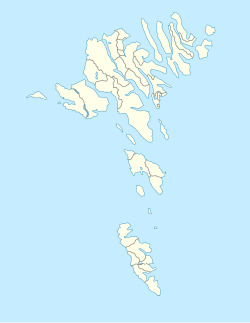|
Norðragøta
Norðragøta (Danish: Nordregøte), also just referred to as Gøta, is a village on Eysturoy island, Faroe Islands. Overview The municipality of Gøta (Gøtu kommuna) was a municipality until 1 January 2009 when it merged with Leirvík into Eysturkommuna. Gøta consists also of the villages Gøtueiði, Gøtugjógv and Syðrugøta. The village lies on Eysturoy's east coast at the bottom of the inlet Gøtuvík. There is a museum called Gøtu Fornminnisavn with the famous house Blásastova. The wooden church in the centre of the village is from 1833. Gøta is a place of great importance in the history of the Faroe Islands. One of the key figures in the Icelandic saga, Færeyinga saga, called Tróndur í Gøtu (Old Norse: Þrǫ́ndr í Gǫtu) lived here. Tróndur was a heathen Viking-chief who ruled all of the islands for a period of time. In the narrative, Tróndur is depicted as the antagonist, juxtaposed against the protagonist, Sigmundur Brestisson. Sigmundur played a pivotal role in the Christianization of the Faroe Islands on behalf of the King of Norway. SportsThe most popular pastime in Norðragøta is football. The local football team is Víkingur Gøta, formerly known as Gøtu Ítróttarfelag. They play their home games at the Serpugerði Stadium. MusicGøta is home to G! Festival, one of the largest music festivals in the Faroe Islands. Faroese stamps showing NorðragøtaOld houses in NorðragøtaIssued on 5 October 1992, the artist was Jákup Pauli Gregoriussen.
Church of GøtaThe new church of Gøta, issued: 23 September 2002. These were also the Christmas stamps for that year.
Text on stamps.fo: See alsoReferences
External links
Information related to Norðragøta |
||||||||||||||||||||||||||||||







